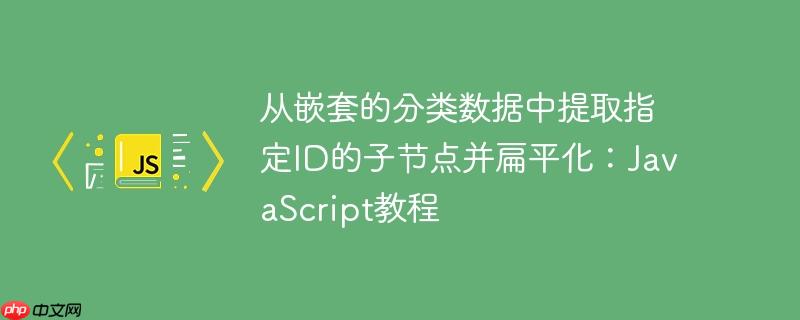
本文档详细介绍了如何使用JavaScript从深度嵌套的分类数据中提取特定ID的子节点,并将结果扁平化为一个数组。我们提供了一个高效的算法,避免了传统的循环结构,而是采用栈数据结构和条件判断,以实现目标。同时,我们还讨论了在没有指定ID时返回父节点和直接子节点,以及在指定ID没有子节点时返回空数组的策略。
在处理具有层级结构的分类数据时,经常需要根据特定的分类ID提取其所有子节点,并将这些节点扁平化到一个数组中。本教程将介绍一种使用JavaScript实现此功能的有效方法,该方法避免了使用for、forEach和while等传统循环结构,而是采用栈数据结构,提供了一种更简洁和可读性更高的解决方案。
首先,我们假设有如下的数据结构,表示分类信息:
interface Category {
name: string;
id: string;
count: string;
depth: string;
children: Category[];
}
const data: Category[] = [
{
name: "Car",
id: "19",
count: "20",
depth: "1",
children: [
{
name: "Wheel",
id: "22",
count: "3",
depth: "2",
children: [
{
name: "Engine",
id: "101",
count: "1",
depth: "3",
children: [
{
name: "Engine and Brakes",
id: "344",
count: "1",
depth: "4",
children: []
}
]
}
]
}
]
},
{
name: "Bike",
id: "3",
count: "12",
depth: "1",
children: [
{
name: "SpeedBike",
id: "4",
count: "12",
depth: "2",
children: []
}
]
}
];以下是实现提取指定ID子节点并扁平化的函数:
立即学习“Java免费学习笔记(深入)”;
interface Category {
name: string;
id: string;
count: string;
depth: string;
children: Category[];
}
const mapCategory = (category: Category) => ({
name: category.name,
id: category.id,
count: category.count,
});
const getCategoriesChildren = (
categoryIds: Category['id'][],
categories: Category[],
) => {
const foundChildren: Pick<Category, 'id' | 'count' | 'name'>[] = [];
if (categoryIds.length === 0) {
return categories.reduce<Pick<Category, 'id' | 'count' | 'name'>[]>(
(acc, category) => {
acc.push(mapCategory(category), ...category.children.map(mapCategory));
return acc;
},
[],
);
}
const stack: (Category & { isDesired?: boolean })[] = [...categories];
while (stack.length) {
const category = stack.pop();
if (!category) continue;
const isDesiredCategory =
categoryIds.includes(category.id) || category.isDesired;
if (isDesiredCategory) {
foundChildren.push(...category.children.map(mapCategory));
}
stack.push(
...(isDesiredCategory
? category.children.map((child) => ({ ...child, isDesired: true }))
: category.children),
);
}
return foundChildren;
};代码解释:
const categoryIds1 = ['22', '3'];
const result1 = getCategoriesChildren(categoryIds1, data);
console.log(result1);
// Expected Output:
// [
// { name: "Engine", id: "101", count: "1" },
// { name: "Engine and Brakes", id: "344", count: "1" },
// { name: "SpeedBike", id: "4", count: "12" }
// ]
const categoryIds2: string[] = [];
const result2 = getCategoriesChildren(categoryIds2, data);
console.log(result2);
// Expected Output:
// [
// { name: "Car", id: "19", count: "20" },
// { name: "Wheel", id: "22", count: "3" },
// { name: "Bike", id: "3", count: "12" },
// { name: "SpeedBike", id: "4", count: "12" }
// ]
const categoryIds3 = ['4'];
const result3 = getCategoriesChildren(categoryIds3, data);
console.log(result3);
// Expected Output:
// []本教程介绍了一种使用JavaScript从深度嵌套的分类数据中提取特定ID的子节点,并将结果扁平化为一个数组的有效方法。该方法避免了传统的循环结构,而是采用栈数据结构,提供了一种更简洁和可读性更高的解决方案。 通过理解和应用本教程中的代码,你可以更有效地处理具有层级结构的分类数据,并提取所需的信息。
以上就是从嵌套的分类数据中提取指定ID的子节点并扁平化:JavaScript教程的详细内容,更多请关注php中文网其它相关文章!

每个人都需要一台速度更快、更稳定的 PC。随着时间的推移,垃圾文件、旧注册表数据和不必要的后台进程会占用资源并降低性能。幸运的是,许多工具可以让 Windows 保持平稳运行。

Copyright 2014-2025 //m.sbmmt.com/ All Rights Reserved | php.cn | 湘ICP备2023035733号